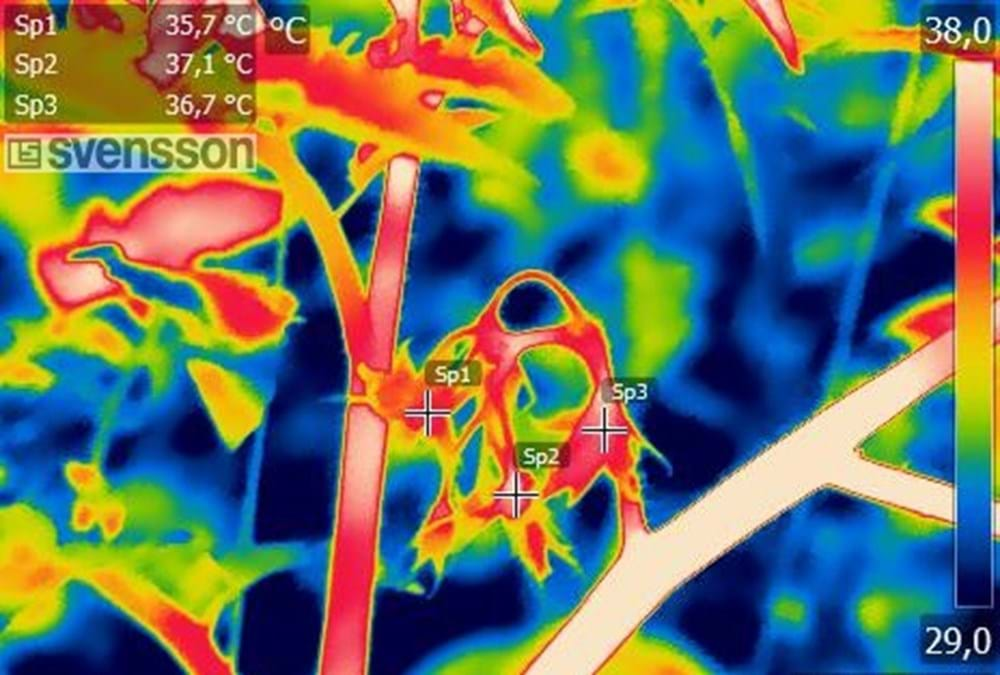Climate House offers knowledge and tools
Beautiful pictures and new insights with a thermal imaging camera
With a thermal imaging camera, you can visualize accurate climate measures such as closing a screen to the plant temperature.
"With the right screen, you can ensure that the crop temperature drops by around five degrees in summer. And in winter, you can increase the crop temperature by about two degrees during cold nights with high radiation. We can demonstrate this with such a camera," says Hugo Plaisier, Svensson's advisor.
The use of thermal imaging cameras is not yet commonplace in greenhouse horticulture. Svensson purchased such a camera this year, with which you can create a very accurate thermal image of the plant, right down to the petals.
Hugo Plaisier: "This allows you to measure the actual plant temperature in the greenhouse very precisely. You can do this in the summer when the sun is shining brightly to demonstrate how hot certain plant parts get. But also in winter to demonstrate how strongly certain plant parts can cool down. So it does the same as an Infrared (IR) plant temperature meter, which measures 5 to 10 m2 of the crop, but much more in detail".

Measuring is knowing
A thermal imaging camera provides beautiful pictures of all individual plant parts and though this creates new insights.
Plaisier: "A standard Infrared plant temperature meter provides one number per 5 to 10 square meters of the crop. A lot less accurate than our thermal imaging camera. If the average crop temperature per square meter is 16 degrees, it may still be the case that certain details of the crop have already reached 14 degrees. Condensation can already occur on those parts - think of flower buds - if the room temperature is higher, which is, of course, undesirable. Such a camera is very illustrative for this purpose."
It is an instrument that requires you to know what you are doing, Plaisier continues, which is why Climate House - a new consultancy branch of Svensson - offers this measurement as a service, among other things.
"It is a step too far for most growers to buy such a camera themselves. We use this camera to create more insight into practice. What is the effect on the crop temperature if you use climate screens and do nothing? We do this with an A / B test by screening some and some not in practice. Measuring is knowing. That sometimes leads to a shock reaction: I did not know that the effect was so great."
New insights
The use of a thermal imaging camera leads to new insights for The New Way of Growing, nowadays referred to as Plant Empowerment, says Plaisier.
"Analyzing the situation together and arriving at well-considered advice, that's what it's all about. You can control the crop temperature if you use the right screen at the right time—both in summer and winter. With the right climate screen, you can ensure that the crop temperature in the summer drops by about five degrees; we measured that with such a camera. And in winter, you can increase the crop temperature by about two degrees during cold nights with high radiation. We can also demonstrate that. I think that the growers who follow the courses of HNT / GPE realize that this is an issue, but it is not always realized how hot or cold certain plant parts could become."
Radiation monitor
Crop temperature and room temperature can therefore deviate considerably from each other, Plaisier continues. Those who prefer to stick to numbers can also work with the radiation monitor, although it is much less accurate.
"With the radiation monitor - an internet calculation model developed by Feije de Zwart (WUR) - you can simulate what the plant temperature will be under certain circumstances. You fill in how much radiation there is from the sun, the indoor and outdoor temperature, and the lighting in the greenhouse. The radiation monitor calculates how much radiation enters and how much goes out. With a negative balance, the plant temperature will fall below the air temperature. Then you have to act on that."
Every grower can use the radiation monitor at www.kasalsenergiebron.nl
Pyrgeometer
A pyrgeometer is ideal, Plaisier concludes. "It measures how much net radiation you have. Every grower should have such a sensor. Then you can let the computer determine when you must take action and when the climate screen must be closed. In practice, this is often in the afternoon, one or two hours before sunset. Then the balance already turns. The sun then becomes weaker, so inocming radiation decreases so outgoing heat radiation starts playing a major role. It may be that your crop will cool down too much. It is then important to close your screen in the afternoon. Some growers only do this when the sun has already set. The 'old thinking' says that light maximization is the most important and the climate screen should only be closed after sunset, the 'the new thinking' takes into consideration the whole picture."
